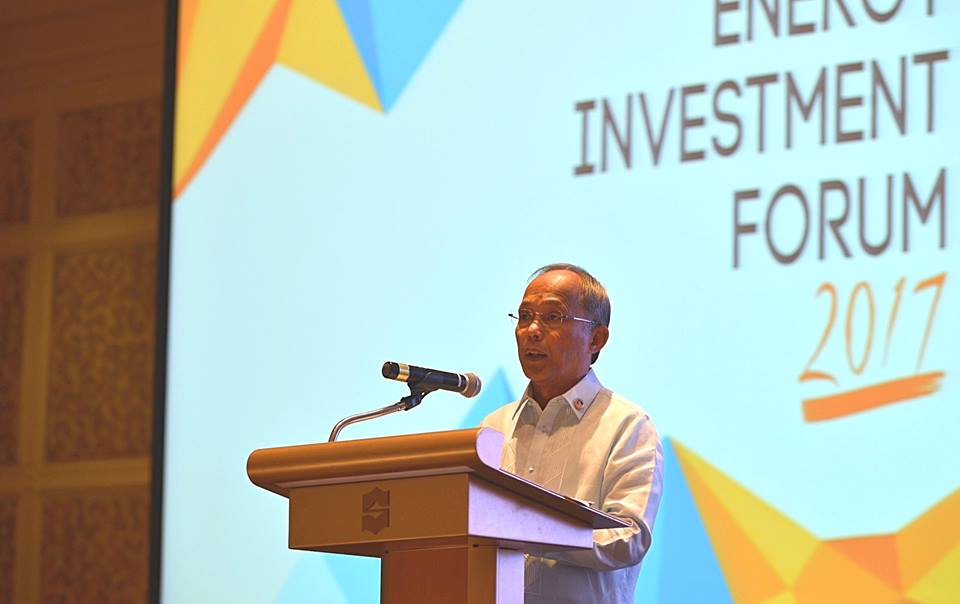News
DOE pushes for 25% contingency power reserve to avoid outages

Energy Secretary Alfonso Cusi said the DOE is seeking that such reserve requirement is established, speaking at the Energy Investment Forum 2017 at Shangri-la Makati Hotel on Thursday. (Photo: Department of Energy Philippines/Facebook)
MANILA — The Department of Energy (DOE) is pushing for a 25-percent contingency reserve requirement for all power generating firms to sufficiently meet peak demands and avert outages due to power plant shutdowns and other causes.
Energy Secretary Alfonso Cusi said the DOE is seeking that such reserve requirement is established, speaking at the Energy Investment Forum 2017 at Shangri-la Makati Hotel on Thursday.
The DOE is in the process of drafting a resiliency plan for the energy sector to mitigate the adverse effects of natural disasters.
Cusi told reporters on the sidelines of the energy investment forum that a 25-percent contingency power reserve at any given time is necessary for the country to have a stable energy supply, as the country is vulnerable to outages due to natural calamities like typhoons and earthquakes.
“A 25 percent reliability reserve is one way the DOE puts supply ahead of demand. In as much as we are trying to bring in investors, we want to be ready with the power demands to be able to keep up with industrialization,” Cusi explained.
He said that on top of the mandated reserves for generation companies (gencos), there should be a 25-percent dispatchable reserve for peak demands.
“Operational transmission reserves are mandated in the gencos franchise and concession. We don’t want a repeat of the kind of long-term brownouts during the late 1980s. That was really bad for the economy,” Cusi said.
The energy chief said recent yellow alerts of some power plants due to both planned and unplanned outages and maintenance shutdowns are the reasons why the availability of reserve power is necessary.
Cusi added it is often a chicken-and-egg syndrome, when existing power infrastructure is a requisite of investors. “We have to be ready when investors say, ‘we will come once you build or have this or that,’” he said.
Cusi highlighted the importance of the forum to address not only the energy security issues, but more importantly, how the country will benefit from the public-private partnership (PPP) in the energy sector.
“Without this joint commitment and partnership, there is no way that we can be prepared to meet some of the energy challenges that lie ahead of us. After all, it is this sense of solidarity and this unique model of private-public partnership that we’ve developed here in the Philippines, that has enabled us to be where we are today,” Cusi said.
In as far as attracting investments, the energy chief also highlighted the fact that the Philippines is six times lower than the global average in carbon emissions, but foreign investors, in particular, choose to establish their business elsewhere because electricity cost here is among the highest in Asia.
The Philippines leads in environmental sustainability, according to Cusi, with a renewable energy mix of 30 percent, the highest in Asia and at par with developed countries in the world.
For three consecutive years, the World Energy Council has ranked the Philippines number-one for environmental sustainability on its Energy Trilemma Index, acknowledging the Philippines’s commitment to sourcing electricity from renewable energy and low-carbon sources, Cusi noted.
“This recognition places us ahead of countries, such as Switzerland, the United Kingdom, and Germany,” he said, adding this is one reason why the DOE proposes that one percent of the contractive capacity of distribution utilities must come from renewable energy.
“This is why more Filipinos have access to reliable and secure electricity, and why the Philippines is a global leader in renewable innovation and environmental sustainability,” Cusi said.





















